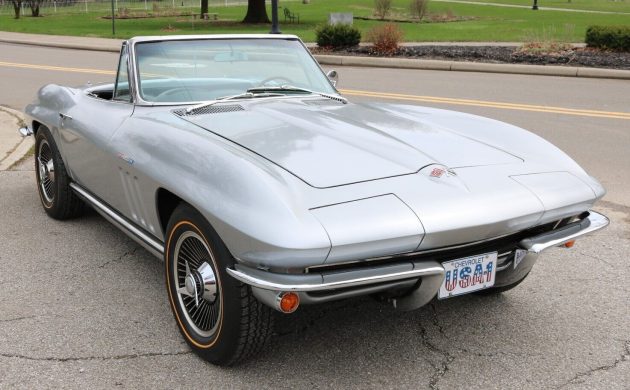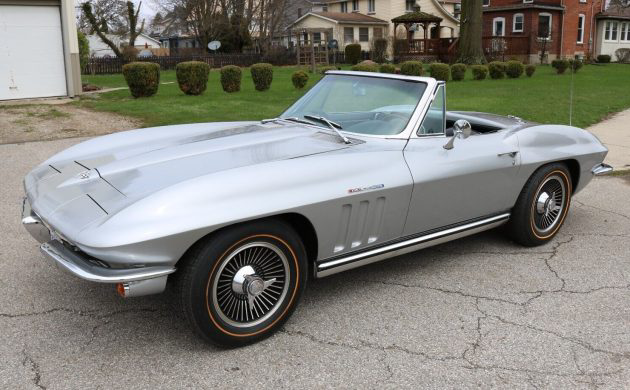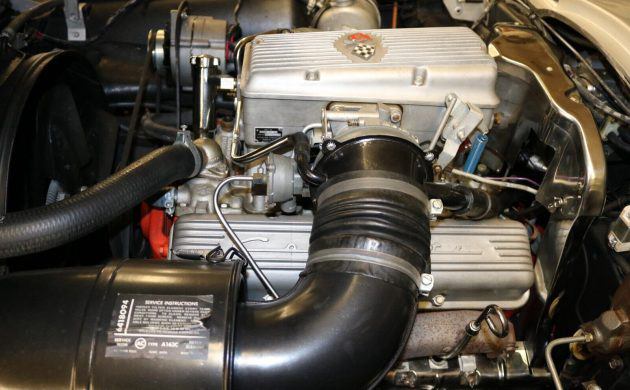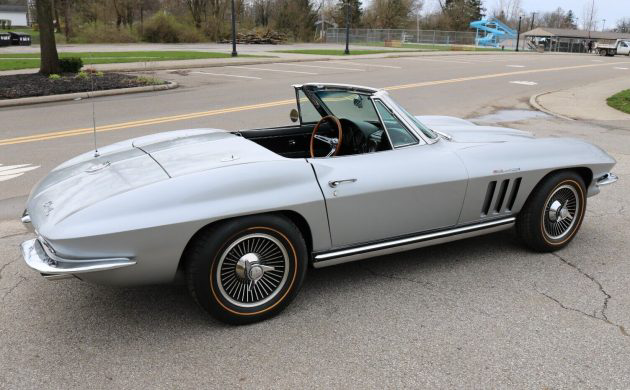
Chevrolet introduced fuel injection to its Corvette range in 1957, creating what was, to that point, the ultimate high-performance variant of its iconic sports car. The “Fuelie” option was an expensive choice, and production numbers remained relatively low as a result. However, the game changed dramatically in 1965 when Chevrolet successfully shoehorned a big-block V8 under the Corvette’s hood. It effectively sounded the death knell for the Fuelie, with the option disappearing at the end of that year. Our feature car is one of those, presenting well as a driver-grade classic. The seller has enjoyed it for two years but feels the time is right for it to find a new home with an enthusiast who will continue to appreciate all that it offers. Therefore, they have listed the Convertible here on eBay in Galion, Ohio. Bidding sits below the reserve at $60,100, although there is a BIN of $85,000 for those who view this Fuelie as an automotive “must-have.”

Chevrolet’s approach for 1965 was to treat its Corvette to minor cosmetic updates, with the most profound changes below the surface. However, those exterior changes had little effect on the car’s appearance, which remained muscular and purposeful. The seller never planned on owning this Convertible, taking it as a trade on their meticulously restored 1969 Camaro Z28. Some will debate who received the better deal because both vehicles are American icons with constantly climbing values. They have enjoyed the car for the past two years, although it has spent some time displayed at the Memory Lane Auto Museum in the seller’s hometown. The Trim Tag confirms that the Silver Pearl paint gracing its panels is the correct shade, but whether the Corvette has received restoration or repairs is unclear. They describe its presentation as driver-quality, suggesting a close inspection will probably reveal chips and marks. However, the fiberglass is excellent, and the underside shots reveal no penetrating rust that would compromise the car’s structural integrity. The occasional spot of surface corrosion is visible, but nothing that should cause the buyer problems. None of the supplied images provide insight into the soft-top’s condition, which is frustrating. The chrome and glass are in good condition for their age, and this ‘Vette is 1-of-1,116 ordered with the desirable knock-off wheels.

Lifting the hood reveals what sets this Corvette apart from its peers. Chevrolet’s fuel-injected 327ci V8 produces 375hp and 350 ft/lbs of torque. When teamed with a four-speed manual transmission, it delivered a ¼-mile ET of 14.2 seconds and a top speed of 145mph. That should have made this the ultimate high-performance variant in 1965, but the company’s mid-year introduction of the 396ci V8 was a game changer. Buyers suddenly had 425hp and 415 ft/lbs under their right foot, and the impact was dramatic. Top speed dropped to 132mph, but the ¼-mile ET plummeted to 13.7 seconds. However, that was the mere tip of the iceberg. Ticking the Fuelie option on the Order Form added $538 to the Corvette’s sticker price. The big-block only cost $292.70, making it easy to understand why 2,157 buyers chose the 396, but only 771 opted for the Fuelie. The jig was up, and Chevrolet quietly phased out the engine at the year’s end. Potential buyers considering the investment potential of this Convertible will welcome the news it is a numbers-matching survivor. The seller provides photos and other information confirming this, and the positive news keeps coming. This classic is in excellent mechanical health, with its V8 coming to life the moment they turn the key. It runs and drives perfectly and can be considered a turnkey proposition.

This Corvette’s first owner wasn’t solely concerned with outright performance when ordering this classic because they ticked many of the more desirable boxes when selecting interior options. The new owner receives power windows, a telescopic teakwood wheel, an AM/FM radio, and a power antenna. They didn’t splash the cash on leather trim, but I can’t criticize them for that choice. The presentation is excellent for a vehicle of this age, with no wear or other issues. The upholstered surfaces are spotless, the bright trim sparkles and there is no carpet fading. Rocking up to a Cars & Coffee in this baby will draw attention for the right reasons, and the interior won’t cause the new owner shame.

There is something undeniably attractive about owning the last of a breed because it is often the best version a manufacturer has produced. That is the opportunity presented by this 1965 Corvette Convertible because the Fuelie option would be a memory by the end of that model year. The bidding hasn’t been as intense as I would typically expect, but some potential buyers might be biding their time before making a move. They may need to be careful because recent sales results suggest the BIN figure is competitive. It is possible that someone could throw caution to the wind and hit the button, and I would be unsurprised if that occurred. Would you do that, or is taking a chance in the bidding war more your style?





Since this is clearly a global site, I’d like to know, do folks from other countries think of what us Yanks think of this car? Perhaps it’s from a time period when most of us budding gear heads were just hooking up, the ’65 Corvette was, well let’s say more than once, Ms. Clapper busted us for drawing pictures of ’65 Corvettes, instead of silly math problems. We built models, hoping someday,,well, for some, the cookie crumbled that way, others, not so fortunate. Does this car give goosebumps to the Brits, like an XKE might, or Italians, some monster Ferrari? Because to anyone that bleeds red, white and blue, this car is it.
You know, I know it’s late, but I’m not tired, and I rip on gray or no hairs paying outlandish sums for these cars. As I age, I can understand now why they do it. They never got their chance before, and by golly, come heck or high water, going to it before they die. Hollywood loves a sap, and a recent Mecum ad showing the guy with a Challenger as a kid, and the wife buys him a real one,,,let’s just say, Hollywood knows a good story.
Hard to underrate nostalgia as a motivator. I’m a fairly active and lifelong cyclist. A number of years ago I bought an old 10 speed off eBay because it was the one. 14 year old me wanted but couldn’t afford. Like cars, modern racing bikes are better in every measurable way than the old ones but, you can’t discount nostalgia.
Cars are orders of magnitude more expensive but the idea is the same. This car is beautiful. I’m not young but not quite old enough for this to hit my button (and I certainly don’t have 85 large in disposable cash). Some of the 70s big block C3’s do get my attention though.
Today, with all the technology at our disposal we can’t have anything as good as this. Sixty years ago having this car was like driving the Future.
All good comments on a beautiful, unique car. As a kid when these cars came out all I could do was drool all over them. As an older geezer I’m still drooling.
As a kid Kitty Sanders had a ‘65. The daughter of a local dentist, pretty as a peach with her blonde hair and driving a Vette as a high schooler. My, oh my. Yep, these cars make us harken back to yesteryear.
I have to admit bias. In 1957, my Father came home with a black Bel Air hardtop with that fancy script on the front fender. A friend he had been in the war with – who I only knew as Amsey, had a Chevrolet store in Goshen, Indiana. He had ordered this car for a friend and could not get the injection to run in any manner except highway speeds. In frustration, he gave the car to my Dad and said that he could send him the money after he sold it. They had a whole different sense of trust and honor in those days. Nobody at our store could make it run at idle either, so it ended up where Dad sent all SAABs, Toyopets and others that wouldn’t sell in Idaho – to the Qvale’s. They would try any brand as they had a much more diverse clientele in San Fran. I always wondered where that beautiful car ended up. I hope that by 1965 they had a few of the bugs worked out.
I had heard that too, that the F.I. unit was troublesome, and many were removed and a carb added. In fact, when you see a F.I. unit for sale today, it’s only because someone took it off the car.
I think the mid 60s Vettes compared favorably with cars like the Jag E-type. There were pros and cons to both. The Vette was designed to idle all day with the AC on and not overheat; it was usable as an everyday car. The Jag had a much less mass-produced look and feel, but it wasn’t as usable as everyday transportation. The Vette had multiple engine choices, but the Jag had that show stopper styling. Who wouldn’t love to own either one?
My opinion:
This car has been hit hard on the snout and then poorly repaired.
The FI unit has a real Rochester plenum data plate, but the unit is from a ’64 Corvette. That means the VIN derivative on the plenum is a re-stamp.
The engine block is a re-stamp.
I agree the grille does not fit well, neither does the hood. The passenger door gaps are also bad. It is/was a hard top car but no mention of the top.
I guess I’m not knowledgeable enough about ’64-’65 FI units to identify the difference.
Please point out the ‘tells’.
Thanks.
It comes down to the unit serial number on the plenum.
Some 7380 units with serial numbers in the low 2000 range were factory installed on early production ’65 Corvettes. However, this Corvette has a VIN in the later part of production when 7380 units with serial numbers in the 3000 range were being installed.
✔️✔️✔️